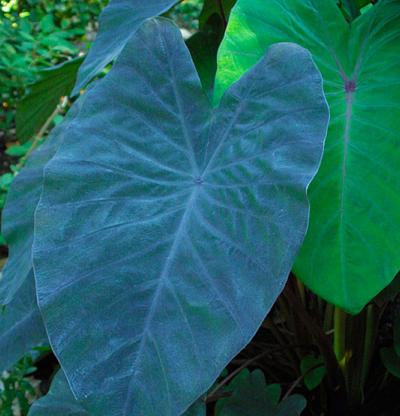





 Elephant ear (Colocasia esculenta 'Black Magic')
kol-oh-KAY-shah ess-kew-LEN-tah
Synonyms:
C. antiquorum
Genus:
Colocasia
Elephant ear (Colocasia esculenta 'Black Magic')
kol-oh-KAY-shah ess-kew-LEN-tah
Synonyms:
C. antiquorum
Genus:
Colocasia
Rising to about 36 inches, the elephant ear's deep-purple stalks suspend luxurious leaves of the same color. When the leaves’ undersides are dusted with chalky-looking bloom, they have an intriguing, almost gray look. This plant does well in a bog or even in the margins of a water garden, as well as in average garden soil.
Noteworthy Characteristics:Dark purple, almost black, heart-shaped leaves. Loves wet conditions.
Care:Elephant’s ears are generally not hardy anywhere colder than Zone 9, so treat them like other summer-blooming bulbs. Let frost kill the top growth, then dig up the bulbs and dry them in open shade. Soon they look shriveled, and any clinging soil dries up and falls off with the roots. Hang them in well-ventilated sacks in a dry, cool (about 50°F) place.When spring arrives, plant the bulbs in 1- or 2-gallon pots and put them in a greenhouse to give them an early start. Position them so that any remnants of last year’s stem rise above soil level. Since the bulbs have no roots at this point, water them once, and don’t douse them again until leaves emerge. Grow in a warm greenhouse or outdoors at a pool margin, in a moist border, or in large aquatic containers.
Propagation:Divide in winter or early spring.
Problems:Soft rot, bacterial blight, corm and root rot, and dasheen mosaic virus are common. Aphids, whiteflies, and spider mites occur.
Copyright © www.100flowers.win Botanic Garden All Rights Reserved